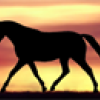quick run down on extension color links
Forums
Re: quick run down on extension color links
Yes. There is only one KIT gene. It has two alleles, one on each chromosome. Any mutations one a single chromosome will be linked to the extension allele on that chromsome, and any mutations on the opposite chromosome will be linked to the extension allele on that chromosome.
Example: A horse carries both roan and DW, and is Ee
That horse could be-
E------------------Rn--DW---
e------------------rn--dw--- (E is linked to both Rn and DW, e is linked to rn and dw)
or
e-------------------Rn--DW--
E-------------------rn--dw-- (e is linked to both Rn and DW, E is linked to rn and dw)
or
E-------------------Rn--dw--
e-------------------rn--DW-- (E is linked to Rn and dw, e is linked to rn and DW)
and so on. In the first example, most foals born will be either dominant white or solid chestnut. In the second example, most foals will be either dominant white or solid black. In the third example, most foals will be black roan or dominant white. You get the idea!
Re: quick run down on extension color links
[quote="horsegen"]Yes. There is only one KIT gene. It has two alleles, one on each chromosome. Any mutations one a single chromosome will be linked to the extension allele on that chromsome, and any mutations on the opposite chromosome will be linked to the extension allele on that chromosome.
Example: A horse carries both roan and DW, and is Ee
That horse could be-
E------------------Rn--DW---
e------------------rn--dw--- (E is linked to both Rn and DW, e is linked to rn and dw)
or
e-------------------Rn--DW--
E-------------------rn--dw-- (e is linked to both Rn and DW, E is linked to rn and dw)
or
E-------------------Rn--dw--
e-------------------rn--DW-- (E is linked to Rn and dw, e is linked to rn and DW)
and so on. In the first example, most foals born will be either dominant white or solid chestnut. In the second example, most foals will be either dominant white or solid black. In the third example, most foals will be black roan or dominant white. You get the idea![/quote]
Ok so let me see if i get this. Because there are only two alleles there could never be an occurrence of say
E -- DW Rn To
e -- dw rn to
because there would have to be three alleles to make that possible?
Re: quick run down on extension color links
[quote="admin"]
Ok so let me see if i get this. Because there are only two alleles there could never be an occurrence of say
E -- DW Rn To
e -- dw rn to
because there would have to be three alleles to make that possible?[/quote]
No, the alleles are each side (If I am remembering right.) So in horsegens first example
E------------------Rn--DW---
e------------------rn--dw---
RN and DW are on one allele.
rn and dw are on the other allele.
So DW RN and TO could all be on the same allele (at least theoretically.)
[quote]RMT - are you in vet school? Or an animal science student?[/quote]
Nope, not in vet school. Currently a Bio major.
Re: quick run down on extension color links
[quote="Jenks"]RMT - are you in vet school? Or an animal science student?[/quote]
I can say from experience that you get absolutely no training in genetics from vet school. Just the other day, someone said that there is a disease linked to the black and tan coat pattern. When I asked how the disease was linked to the agouti gene or if it was a familial/breed type linkage that happens to occur in a breed with that color predominantly, you could have heard crickets chirping in the background to go along with the blank stares I received. :BH
Re: quick run down on extension color links
[quote]No, the alleles are each side (If I am remembering right.) So in horsegens first example
E------------------Rn--DW---
e------------------rn--dw---
RN and DW are on one allele.
rn and dw are on the other allele.
So DW RN and TO could all be on the same allele (at least theoretically.) [/quote]
Yes, every mutation will have two alleles. You can have any number of mutations in the same gene. If you think about it, every horse has two alleles for extension, two alleles for roan, two alleles for dominant white, two alleles for tobiano, two alleles for SB1...the list is endless. Now, both alleles may be "wild type" and so the horse doesn't show that phenotype (for example, sb1/sb1), but they still have two alleles of it:
E----------------Rn--DW--to--sb1--
e----------------rn--dw--to---sb1--
Just because you can't see them doesn't mean they aren't there. In the example above, most foals will be dominant white or solid chestnut. It's only when one of them is "mutant" and the phenotype pops up that you can see the linkage between phenotypes. Let's say that the horse above actually inherits this:
E----------------Rn--DW--to--sb1--
e----------------rn--dw--TO---sb1--
Now most foals will be either dominant white or chestnut tobianos. Or how about this?
E----------------rn--DW--to--sb1--
e----------------Rn--dw--TO---SB1--
Now most foals will be dominant white or chestnut roans with both tobiano and sabino! The KIT gene has a lot of known mutations, and a horse can carry an infinite number of them on a single chromosome. There's no "limit" to the number of mutations (and phenotypes) that can occur in a horse. Now, we don't usually see this in animals, but it is theoretically possible. Is that clear? :D
Re: quick run down on extension color links
[quote="horsegen"][quote]No, the alleles are each side (If I am remembering right.) So in horsegens first example
E------------------Rn--DW---
e------------------rn--dw---
RN and DW are on one allele.
rn and dw are on the other allele.
So DW RN and TO could all be on the same allele (at least theoretically.) [/quote]
Yes, every mutation will have two alleles. You can have any number of mutations in the same gene. If you think about it, every horse has two alleles for extension, two alleles for roan, two alleles for dominant white, two alleles for tobiano, two alleles for SB1...the list is endless. Now, both alleles may be "wild type" and so the horse doesn't show that phenotype (for example, sb1/sb1), but they still have two alleles of it:
E----------------Rn--DW--to--sb1--
e----------------rn--dw--to---sb1--
Just because you can't see them doesn't mean they aren't there. In the example above, most foals will be dominant white or solid chestnut. It's only when one of them is "mutant" and the phenotype pops up that you can see the linkage between phenotypes. Let's say that the horse above actually inherits this:
E----------------Rn--DW--to--sb1--
e----------------rn--dw--TO---sb1--
Now most foals will be either dominant white or chestnut tobianos. Or how about this?
E----------------rn--DW--to--sb1--
e----------------Rn--dw--TO---SB1--
Now most foals will be dominant white or chestnut roans with both tobiano and sabino! The KIT gene has a lot of known mutations, and a horse can carry an infinite number of them on a single chromosome. There's no "limit" to the number of mutations (and phenotypes) that can occur in a horse. Now, we don't usually see this in animals, but it is theoretically possible. Is that clear? :D[/quote]
I apologize for the stupid question, but here it goes:
You say 'most' because there is some small possibility of these actually switching (I forget what you call that) but don't the strands just roil around swapping out allelles many times? Or is that only on a higher level? the gene level mostly? so less likely?
Re: quick run down on extension color links
[quote="Monsterpony"][quote="Jenks"]RMT - are you in vet school? Or an animal science student?[/quote]
I can say from experience that you get absolutely no training in genetics from vet school. Just the other day, someone said that there is a disease linked to the black and tan coat pattern. When I asked how the disease was linked to the agouti gene or if it was a familial/breed type linkage that happens to occur in a breed with that color predominantly, you could have heard crickets chirping in the background to go along with the blank stares I received. :BH[/quote]
Wow. I'm surprised....
Re: quick run down on extension color links
Ok I got it. Thanks for the explanation and here is another question.
Lets say theoretically that you have a horse with
E--TORNDW
e--torndw
and your crossover rate is 7% for each mutation. So your chances of the entire string staying together would only be 79%. Am I calculating this correctly?
So the longer the string is the more unstable it is.
Re: quick run down on extension color links
[quote="admin"]Ok I got it. Thanks for the explanation and here is another question.
Lets say theoretically that you have a horse with
E--TORNDW
e--torndw
and your crossover rate is 7% for each mutation. So your chances of the entire string staying together would only be 79%. Am I calculating this correctly?
So the longer the string is the more unstable it is.[/quote]
The 7% is for the whole KIT gene to crossover. So if a switch happens it would be from this
E--TORNDW
e--torndw
to this
E--torndw
e--TORNDW
I am not sure it's possible for the mutations on KIT to switch around. I actually think that crossover on KIT may be impossible. If it is not, I believe the percentage will be much lower than 7% as the reason it is 7% is because of the distance between E and KIT. The distance between the mutations would be MUCH smaller and thus a MUCH smaller percentage.
Re: quick run down on extension color links
"Crossover" is a measure of how often a chromosome will recombine (break and swap strands) between two points. The crossover rate between extension and KIT is estimated at 7%. That means you would expect to see a recombination event between the extension allele and ALL the KIT alleles (together) 7% of the time. The greater the distance between two genes or mutations, the greater likelihood that a recombination event will occur between them. Saying that extension and KIT are linked with a crossover rate of 7% means that 93% of the time, you will the linkage of the alleles (black with tobiano and chestnut with solid, for example), but 7% of the time, you will see them switch (you'll get a foal that's chestnut with tobiano or black with solid).
A crossover between two different KIT mutations is going to be much, much rarer, because these mutations are all very close together. I'd have to look up how big the KIT gene is and how much space there is between each known mutation to tell you for sure, but it's probably less than 1% for each pair of mutations. (Tobiano could be a slightly different story, as it is not a mutation that is actually in KIT.) But as a general rule, we don't expect to see recombination between different KIT mutations.
Re: quick run down on extension color links
Ok thought of another question. If you have a sire that is
E -- To and a dam that is
e -- Rn then you have a 7% cross over rate for both the sire and the dam.
So you would have a (100-7-7-Y)% chance of everything staying the same, and a 7% crossover for the sire, a 7% crossover for the dam, and Y% chance of both sire and dam crossing over? Is that right? What would the percent for both of them crossing over be?
I'll be done with this soon I promise then I can show everyone why I'm being so exact with all the questions.
Re: quick run down on extension color links
I'm not sure what you mean by the sire and the dam genotypes. I need to see both chromosomes to know what you'd get. Is the sire heterozygous for extension and tobiano? Is the dam homozygous extension and heterozygous for roan? That would look like this:
E--------To---rn
e--------to---rn
crossed with
e--------to---Rn
e--------to---rn
If so, you would have a 93% chance of getting a black roan tobiano, a black tobiano, a chestnut roan, or a solid chestnut (13.25% chance of each). The other 7% of the time you would get a black solid, a black roan, a chestnut tobiano, or a chestnut roan tobiano (1.75% chance of each). With the dam, the crossover event just gives you the same chromosome configurations as the non-crossover event, so her contributions don't change.
Re: quick run down on extension color links
Sorry I didn't pick a very good example. What about in a situation where it would make a difference?
sire is
E--to Rn
e--to rn
dam is
E--To rn
e--to rn
if there is no cross over you get a 25% chance at each of EETotoRnrn, EeTotornrn, EetotoRnrn, eetotornrn
if sire crosses you get get a 25% chance at each of EEtotornrn, EeTotoRnrn, Eetotornrn, eetotoRnrn
if dam crosses you get get a 25% chance at each of EEtotoRnrn, Eetotornrn, EeTotoRnrn, eeTotornrn
and if they both cross get a 25% chance at each of EEtotornrn, EetotoRnrn, EeTotornrn, eeTotoRnrn
what what would be the chance of both the sire and the dam crossing over?
Thanks so much for helping me out on this.
Daylene
Re: quick run down on extension color links
7% x 7%, or .49% (.0049)
Remember, statistically the probability of A and B occurring is always the probability of A times the probability of B. So the chance of the sire crossing over (and the dam not) is 7%, the probability of the dam crossing over (and the sire not) is 7%, and the probability of both crossing over is .49%.
Re: quick run down on extension color links
Ok so the probability of the crossover occurring on parent A is 7%. The probability of the crossover occurring on parent B is 7%. The probability of them BOTH occurring is .49%. Right?
This won't effect the color calculator but I have another question. What is the probability that any given foal of these two parents will carry a crossover from either parent? Is it still 7% or does having two parents that could cross over increase the percentage?
Re: quick run down on extension color links
Ooo, this is getting so mathematically complex!
Okay, so the short answer is that the chance of getting a foal that has one parent cross over but not the other is actually 6.51%. This is because statistically, it is the chance that one parent will cross over (7%) multiplied by the chance that the other parent will NOT cross over (93%). But when we talk about these types of cases, we usually just use 7% for two reasons:
1. 6.5% is really close to 7% and therefore it's easier to just say 7%. It's simpler for people to understand.
2. In order to really SEE the difference between the 6.5% and the 7%, BOTH parents have to have genotypes that allow you to see them crossing over. To see a crossover event between two genes, the parent has to be heterozygous for both genes, otherwise you can't phenotypically see the recombination. This is a pretty rare situation, and so we usually don't use the 6.5%. Even if a horse is e-To/e-to, it still has a 7% chance of recombining--crossover is not something that just happens to double heterozygotes. But you can't tell when that horse does recombine, so we just go with the 7% chance we get from the other parent.
So in the end, the crossover percentages are:
The chance that a single horse will not experience a recombination event: 93%
The chance that a single horse will experience a recombination event: 7%
The chance that, in a mating, neither parent will experience a recombination event: 86.5%
The chance that, in a mating, ONE (either) parent will experience a recombination event: 6.5%
The chance that, in a mating, BOTH parents will experience a recombination event: 0.5%
So the answer to your question (about the foal) is 13% (6.5% chance from one parent plus 6.5% chance from the other).
Does that make sense?






Re: quick run down on extension color links
Extension is connected to anything on KIT, which includes Roan, Tobiano, all the Dominant Whites, and SB1 currently.